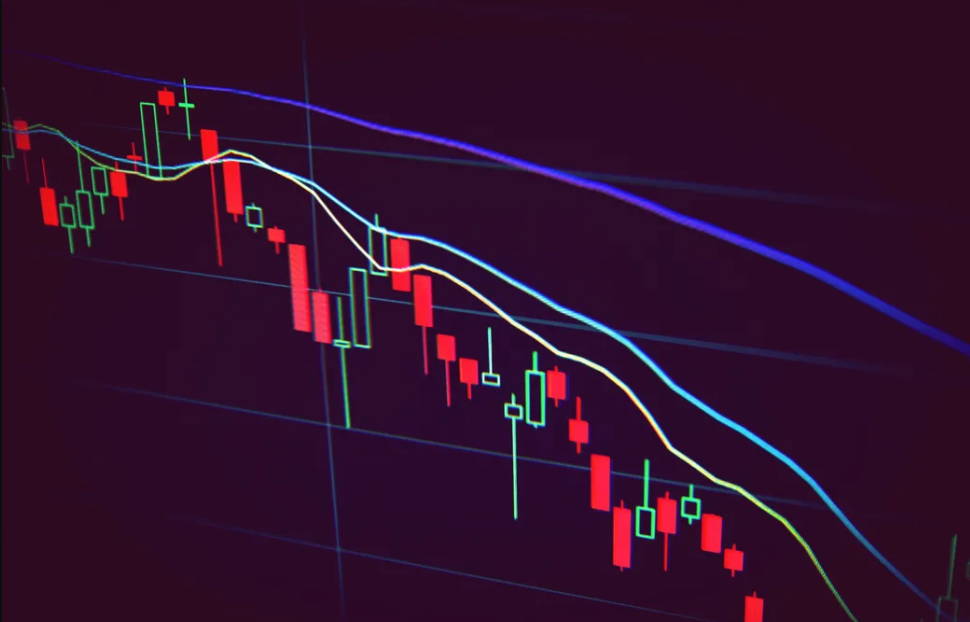In the current whirlwind of dismay and disappointment (or should I say shock and shame?), many in the Bitcoin ecosystem are no doubt fondly remembering simpler times when the bitcoin currency crashing was all we had to stress about. In 2011, BTC’s drawdown reached 93%, a market cap loss of $172 million. The 2014-15 crypto winter saw bitcoin market cap lose over 80%, wiping out $11.3 billion of value. Sigh, those were the days.
Obviously, I’m not serious – that time was, no doubt, shockingly painful for anyone in the industry back then. The Mt. Gox implosion at one stage felt existential – sure, the Bitcoin blockchain would continue to exist after the largest exchange turned out to be engaged in fraud, but would anyone care? The fallout, however, was limited to a relatively small circle of libertarians, cryptographic experimenters and the techno-curious. It was barely covered in the mainstream press. This turned out to be a blessing because the bruised could get to work rebuilding, out of the glare of mainstream attention.
Noelle Acheson is the former head of research at CoinDesk and Genesis Trading. This article is excerpted from her Crypto Is Macro Now newsletter, which focuses on the overlap between the shifting crypto and macro landscapes. These opinions are hers, and nothing she writes should be taken as investment advice.
The contrast with today’s market could not be more stark because the world has been flooded with a torrent of headlines covering every possible angle of the FTX exchange’s implosion. Wednesday’s Andrew Ross Sorkin/Sam Bankman-Fried interview at the New York Times’ DealBook Summit was viewed by probably hundreds of thousands, if not millions of people. The extent of the fallout is as yet unknown, there is serious talk about how it might impact traditional finance and skeptics feel they should be involved in shaping what the reconstruction might look like. The damage has hit thousands of assets, costing almost $160 billion in market cap.
Back in 2011-2015, bitcoin was the whole market. Now, that is far from the case. This is unreservedly good – the range of technological spin-offs and evolving use cases has probably surprised even the most optimistic of the early adopters. And the rapid spread of interest and adoption has grown the value of the entire market. It has also, through diversification, reduced overall market risk.
This last assertion may sound out of place, given the implosion the industry has just witnessed. But it has been an industry implosion much more than a market implosion. The market still works. Crypto assets (with a couple of notable exceptions) are still doing what they do. Bitcoin still produces secure blocks, Ethereum still pays staking rewards, decentralized finance (DeFi) tokens continue to incentivize platform participation, value is still transferred on-chain. The market infrastructure has changed; the market itself, not so much.
We can see this in a key metric that serves as an indicator of sentiment, and that I subliminally introduced in the previous paragraphs: bitcoin dominance. This is simply the percentage of total crypto market cap accounted for by BTC, and is tracked through the BTC.D index. Up until the emergence of Ethereum in 2015, it was around 99% (a few smaller tokens had emerged, none of which gained significant traction). Ethereum’s early success triggered a Cambrian explosion of innovation, new tokens emerged at an astonishing pace and the initial coin offering frenzy of 2017 pushed bitcoin’s dominance down to 37%. The drop coincided with a 470% increase in the overall crypto market cap in the space of approximately three months.
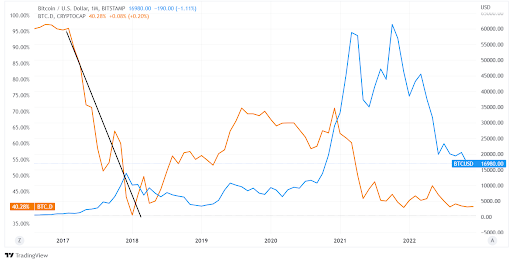
This introduces a salient feature of bitcoin’s dominance: its role as a sentiment gauge. In times of high speculation, such as in late 2017, BTC.D drops. BTC is the least volatile of the non-stablecoin crypto assets, and when traders and short-term investors are feeling confident they tend to prefer the high-risk/high-reward offered by some of the smaller tokens.
The 2018 crash and the ensuing bear market reversed that trend. The speculative assets fell by much more than the relatively “stable” bitcoin and its dominance climbed, reaching over 70% in August 2019. Then the market got confident again, new layer 1 blockchains attracted attention, and BTC.D headed down, reaching 58% a year later. We then saw an unusual phenomenon – a speculative market in which bitcoin was a star performer. In August 2020, MicroStrategy announced its first major BTC purchase; in the following weeks, several other firms, funds and millionaires revealed BTC holdings. The institutions had arrived.

In early 2021, BTC corrected from its highs just as institutional and celebrity interest in other tokens started to take off, with a flurry of new funds, new listings and new services. BTC.D dropped as lower-cap tokens took the spotlight, outshining BTC’s performance even as it reached its all-time high of $69,000 on Nov. 10. The following chart shows how the normally high 60-day correlation between BTC and other tokens dropped sharply during this period.
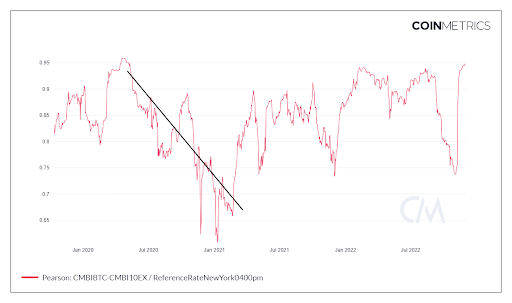
We’re getting to the weird part: BTC.D spiked during this year’s May/June market drama along with a rotation into the relatively “safe” crypto asset, although the metric remained below 50%. It then understandably declined as the dust settled. But it hasn’t really moved since, even though there has been plenty of cause for fear.
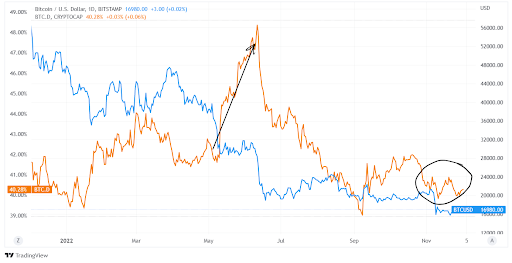
Over the month of November, as the FTX contagion rippled through the system, crypto’s market cap lost 15%. Yet, BTC.D oscillated between 40.0% and 40.9%. It can’t possibly be telling us that sentiment is flat.
Has BTC.D lost its role as a sentiment gauge? That would imply that BTC has lost its role as the “safe” crypto asset. Or could there be something else going on?
It’s possible that BTC has not outperformed other crypto assets because, rather than rotate into relative safety, investors have largely left the market. BTC spot volumes have dropped to local lows after the panic spike earlier this month. But they are still above levels at the beginning of the year, while those for ETH are notably lower. This feels like an exit but not a massive one.
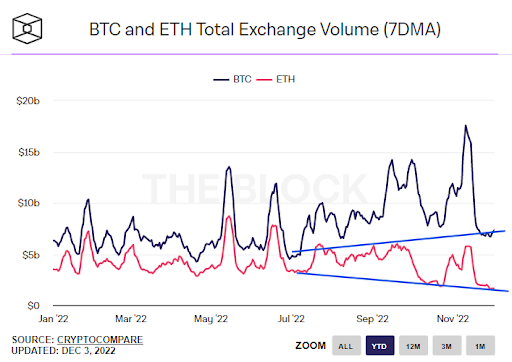
It’s more likely that we are witnessing the consolidation of the crypto market’s speculative nature.
This may sound alarming as many of us now instinctively recoil at the thought of more speculation, after the damage done to portfolios and reputation by shady actors over the past year. We also flinch just imagining how regulators are sharpening their knives to excise heightened risk from the market. All this is reasonable, as is the relief felt by builders and creators that the industry can focus on the constructive aspects of crypto potential now that risky froth has been washed out.
Only, it hasn’t. We’re seeing this not only in the flat BTC.D but also in the performance of some smaller tokens. Over the past month, one of the worst for crypto in recent memory, litecoin (LTC), is up over 25%, OKEx’s token OKB is up more than 36%, the Binance ecosystem wallet’s token TWT is up over 110% and DeFi exchange GMX’s token is up over 33%. The past week has produced scores of 10+% jumps among medium-cap tokens such as dogecoin, AAVE and Uniswap, among others.
The FTX implosion has not removed speculation; nor has macro uncertainty plus the broad withdrawal of liquidity from crypto and traditional markets. What will? Nothing. Speculation is here to stay.
As much as some of us may wish it away, speculation is a feature of free markets. It is also a feature of sophisticated ones, and we want crypto markets to be both. Speculators may be all about buying an asset and selling at a higher price (or selling an asset and buying lower if they’re shorting) rather than actually contributing to a project’s growth. But that is a key feature of markets – the freedom to buy and sell at prices we deem fair. Without the ability to express different opinions, markets become predictable and altogether uninteresting.
They also become less useful – speculators may contribute to volatility, but they also enhance price discovery by reflecting opinions weighted by capital, closing arbitrage gaps and providing exit liquidity.
Speculation is not harmless: It can destabilize markets, especially if done with high leverage. But in most cases the issue is more with the facilitating platforms than with the trading behavior. Many critics point to the price distortions as evidence of speculative damage, conflating aggressive trading with market manipulation. In the confusing aftermath of the FTX implosion, even industry insiders are assuming that speculation rather than a violation of trust was at fault. And for many of us who are in this industry because of its potential to improve financial freedom and integrity, the desperate rush for returns feels, well, uncomfortably superficial.
Speculation bashing may align with many core crypto values, and it does have a certain cathartic utility, but it is pointless. The strange behavior of BTC.D during the recent turmoil tells us that the market composition has changed. Bitcoin is still the anchor asset, by a wide margin, but the volatility of its protagonism is weakening. This is a sign of a maturing asset class. That this should become apparent during one of the industry’s darkest times is cause for hope.
Source: CoinDesk

